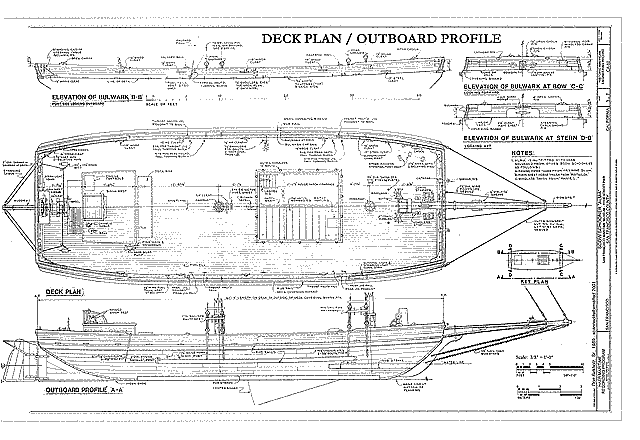 |
| Easy to improve on these lines... or is it? |
A Short Review of Traditional Sailing Box Barges
Box Barges (Scows) aren't new kids on the block. After the log, dugout and raft... barge.
For most of that span, they've been rigged for sail. And not just until folks knew better. Right up into the last of the Age of Sail, outlasting the clippers.
Take a look at the picture of the barge-ketch, above. It's likely a Great Lakes boat from near the late 1800s or early 1900s. She likely hauled freight in competition with any number of Curvy Dogs serving the same ports. Not only did she hold her own, but a whole fleet of her sisters were thriving in the same waters.
But look at those lines! Her steep, knuckled entry and exit are close to poor as can be. And this in a day when quality wood and skilled labor were in relative abundance.
An abrupt entry means plowing water. An abrupt exit means a turbulent (draggy) release.
The economic advantages she gains through simple construction and maximum capacity on given footprint must have been enormous to outweigh making the slightest concession to speed! Hullwise, anyway... that rig looks speedy to me!
Still, if you ask me, those knuckled ends strike me as hard or harder to build than curves. And they wouldn't give up that much displacement. And with that bowsprit, lengthwise port costs couldn't have been a huge factor.
So it's a bit of a mystery that they built them so abrupt. Did they need to make the most of the deadflat for, say, stowing lumber?
 |
| ALMA, getting slipperier. |
Here's ALMA, a San Fransisco Bay Hay Scow. Similar coasters carried Russian ice cut from Swan Lake, New Archangel (now Sitka, Alaska) to SF... no small feat, today... that's still one rugged coast!
Lines are getting easier (longer and less abrupt)... more bottom curve and angle at both ends.
We note that the exit is easier than the entry. Curious. Is this an evolved, hydrodynamically efficient arrangement? Or is it some holdover from the old (discredited) cod's head / mackerel's tail rule-of-thumb?
Let's establish a convention for talking about the proportions of aft curve : deadflat : fwd curve... looking at ALMA, I'm going to guess about 1/4 : 5/8 : 1/8 of LOD (Length On Deck).
 |
| Civil War era blockade runner (replica built by Crystal River Boat Builders) |
Here's one built to run wartime blockades... in other words, didn't want to be loitering around. I'll assume she wasn't slow, nor does she look it.
But she was also running supplies to ravenous armies, and likely slipping up sloughs and creeks to get out of sight. Of course she's a scow!
Proportions look to be about 1/3 : 1/3 : 1/3 (see also other pics of SPIRIT on related sites).
For the first time, we see an easy entry. Did this contribute to speed?
 |
| ANNA, looking sleek! |
ANNA looks to be about 1/2 : 1/4 : 1/4... hard to tell... her aft curve is so long and easy that it could be anywhere from 1/3 to 1/2?
Here again, the entry is more abrupt than the exit, though it didn't seem to tarnish her reputation.
*****
So the question remains... is the blunt-ish bow fast enough to make no never-mind? Is the easy exit and release the real key to increased speed? Or is it an artifact of having aft cockpit and quarters aft, rather than heavy cargo? Or both?
Fortunately, we see 'good enough' anywhere in the range.
My guess is that a moderate curve forward gives good performance, rises well to waves and pounds less in most conditions, while an easy exit lets the hull pick up and go. Other considerations can push or pull the shape this way or that without undue penalty.
*****
An interesting aspect of traditional boats is that they were seldom designed, per se, but rather evolved. Any more efficient variant, relative to the job at hand, tended to get copied.
Today, we tend to think in terms of speed or windward ability as the prime criteria for comparisons. But historically, at least among working craft, economy was paramount.
And economy is a gestalt of factors.
Even our first example was economical. We may no longer remember the reasons, but those who built and worked those pug-nosed vessels likely knew to the penny where profit lay and where not.
And that gestalt doesn't begin and end with the vessel itself, nor even its interactions with wind and sea. It perfectly reflects the state of supply and demand of its time; personnel, materials, cargoes, markets, competitors... even laws and the ability to enforce them. Of course speed and windward ability factor in, but they don't always have the only, or even the last say.
Our own lives have their own economic considerations. We want the best return on our investment, but 'best' is a fuzzy, nebulous, personal affair. And we're often led to look where our best interests are not, by those who would sell us a load.
We and the vessel we choose - if the relationship is to be a happy one - must also find economic balance.


